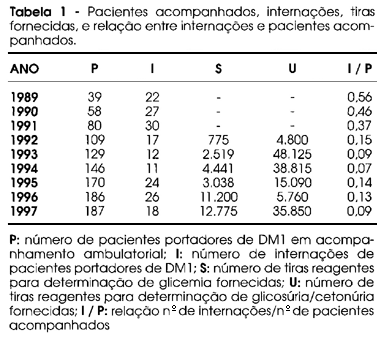Several therapeutic strategies have been used to improve control of patients with type 1 diabetes mellitus 1 (DM1), most of them based on capillary glycemia determinations. Considering the difficulty to have frequent capillary blood letting due to stress and the high cost of reagent strips for home glycemia determinations, we have often used glycosuria as a parameter of glycemia. In 1990 a group was established in our service to treat DM1 patients. Since 1992 all patients have been asked for home monitoring glycemia and glycosuria/ ketonuria. Free reagent strips were given to destitute patients. The aim of this work was to evaluate the benefits of home monitoring. We have correlated the outpatient number (P); the number of hospital admittances (I); the number of blood (S) and urine (U) reagent strips granted yearly; and the ratio for hospital admittances/followed up patients (I/P). We observed that, besides the increase in the number of patients in regular attendance, there was a decrease of 6 to 8-fold in hospital admittances compared to the same parameters obtained during 1989. These results are accompanied by an increase on the number of reagent strips distributed. An inverse correlation (r= -0.83; p< 0.05) between the number of urinary reagent strips distributed and the percentage of hospital admittances was found. Our results indicate that despite the low importance the literature gives to the urine test it can be considered as an important tool for controlling DM1 pediatric patients.
Diabetes mellitus; Diabetic children; Home-monitoring



